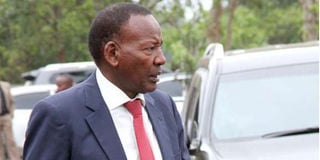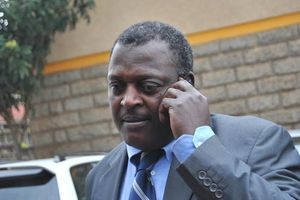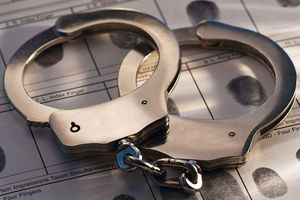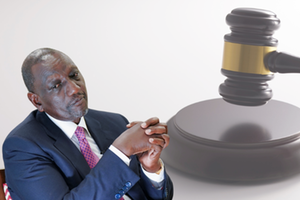Premium
How Nkaissery reacted to Saitoti death, Somalia war

Former Interior Cabinet Secretary Joseph Nkaissery.
I do not know the extent to which General averted a rift on the day Internal Security Minister and MP for Kajiado North George Saitoti died.
I remember Sunday, June 10, 2012, very clearly.
We were in church at the Nairobi Baptist attending the early service. I saw General pull his phone out of his pocket at some point, glance at it and then put it back in the pocket as he continued looking straight at the pulpit, listening to the sermon. After a few moments, he walked out.
General never left a service midway. He hadn’t said anything to me so I assumed he would come back. He did, after 10 or so minutes.
I turned to study him, to see whether there was something wrong. His face gave away nothing, his body language was as before. Calm.
As we walked out of the sanctuary at the end of the service, someone at the door stopped him with the words, “Have you heard what has happened?” I asked, what? Someone else said, “General, pole sana (I am so sorry). I turned to General in fear, “What has happened?” All he said was, “I will tell you later.”
He broke the news to me on the way home, saying no more than that Saitoti and his Assistant Minister Orwa Ojode had perished in a helicopter crash over the Ngong Hills that morning, on their way to a harambee in Ojode’s Ndhiwa Constituency.
Nothing more. No rumour, no speculation.
General dropped us at home. No lunch out for the family that Sunday. No explanation of where he was going or what he was going to do there.
General was so discreet. He never gave you information you did not need, less still when it wouldn’t be of any use to you. He lived the Army motto ‘Ngao ya Taifa’, the country’s shield, and remained calm under pressure, quietly strategising for solutions. No room for mistakes.
Through rehearsal, review, rethink, he tried to make certain that no life would be lost to bad decision-making.
Looking at him, you could never tell what he knew or what he was feeling. Half the time, I didn’t know what he knew at government level or was involved in. He shielded the children and me, just as much as he shielded our country.
Operation Linda Nchi
In October 2011, while he was an Assistant Minister of State for Defence, Kenya decided to go to war in Somalia.
I was not privy to the ministerial, Cabinet, or parliamentary conversations that led to the decision to launch Operation Linda Nchi as it is called. I only knew what was in the public domain.
As Parliament learnt from General, two Kenyan soldiers, Senior Sergeant Jonathan Kangogo and Corporal Evan Mutoro, had been captured by insurgents on July 24, 2010, during an operation in a North-eastern border town.
The following year, Kenya signed a deal with Somalia’s Defence Ministry for collaboration in the war on the al-Shabaab terrorist group. There were other incidents of border attacks and incursions by al-Shabaab along the border with Somalia ending in the abduction of Kenyan aid workers in Dadaab, a couple in Kiwayu Safari villages in Lamu, and a French tourist lady.
About 4,000 Kenyan soldiers were deployed in Operation Linda Nchi and “on 14 October 2011, KDF crossed into Somalia, commencing the first full-scale war in the territory of a neighbouring state since the Independence of Kenya in 1963.”
At home, General was his usual self, nothing to suggest anxiety or tension and no discussion on the war. It was only when he appeared in Parliament to answer questions on behalf of the government that I would know what was happening and not necessarily what he thought of the war. This he kept to himself in true military fashion.
In a motion on the African Union Mission in Somalia (Amisom), which he backed, he seemed to have more questions than answers.
“One, as we convert to be part of Amisom, we want to know command and control aspect. Will our soldiers be under the command of Amisom, or are we going to operate as a sector, so that we maintain respect and professionalism? That is one thing which will be decided at the AU.
Amisom command
“Mr Deputy Speaker, Sir, ‘command’ is a very technical aspect in operations. If it is not integrated, it can bring risk and casualties even to the troops. So, we want to know who will be in charge of our troops.
“The other issue, which is very important … When we deploy, we use our equipment and resources. When we convert to Amisom, it will be Amisom equipment. Therefore, we will definitely require the support of the international community… The other important issue is consistent political goodwill in this operation of Amisom. It is important to know this. In every peace keeping, there is mission grip. Mission grip is going to be issues of violations of human rights. We want our forces as we join Amisom to be specifically under specific command of our own troops. That is very important, so that when mission crip [sic] come in, we shall not be blamed as an overall aspect.”
General’s colleagues clued into his concerns over Amisom and there were several interruptions challenging his conviction in the mission before he completed his response in support of the motion.
Assistant Minister for Foreign Affairs Richard Onyonka (then Kitutu Chache MP) came to General’s defence.
Onyonka explained the international statutes that Kenya was bound by and gave assured that there was “no need to worry about who is actually going to be in control.” I can’t say whether or not General had doubts about Amisom, but I know that with Parliament’s approval, Kenya became part of the Amisom effort.
The war became a long one, with General witnessing it from many sides – as Assistant Minister for Defence, as opposition MP and finally as Cabinet Secretary in charge of Interior and Coordination of National Government.
One thing that came out of this war that I know General took great pride in is the launching in 2012 of October 14 as the official Kenya Defence Forces Day. It is a day when the military remember and celebrate their heroes and heroines and the President, in his capacity as Commander-in-Chief, spends the day at whichever barracks is hosting the festivities.
Tomorrow: Appointment to Cabinet and the pitfalls that came with the docket; his last day.
Also Read the first instalment: Day a furious Kenyatta blasted Gen Nkaissery at State House
Also Read the second instalment: The tense phone call that reassured me of Nkaissery's love for me
Also Read the third instalment: The General and I: Day grave seller sent me on a frenzied drive across America
Also Read the fourth instalment: When Nkaissery turned down Kibaki's appointment
©Helen Nkaisserry / Santuri Media, 2022




